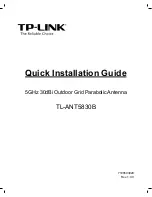
RF200/500 user manual
8
Antenna Factor tabular data
Freq(MHz) A.F. (dB/m)
30
0
40
-1
50
-2
60
-3
70
-5
80
-7
100
-9
120
-9
140
-8
160
-7
180
-6
200
-5
Freq(MHz) A.F. (dB/m)
220
-3
240
-2
260
-4
280
-5
300
-3
320
-2
340
-1
360
0
380
1
400
2
420
3
440
3
Freq(MHz) A.F. (dB/m)
460
4
480
5
500
5
550
6
600
7
650
9
700
10
750
11
800
12
850
13
900
13.5
950
14
1000
14.5
3.0
Ground plane
In general, any UUT will emit radiation in all directions. Some of this will impinge on
the ground which will partially reflect this radiation.
When measuring emissions in the far field, the signal received by the antenna will
comprise a direct signal and a signal which has been reflected from the ground.
(Assuming that the test site has been chosen so that no other reflections are present).
The amount of this reflected signal depends on ground conditions and may vary very
considerably in amplitude. On ‘soft’ ground such as earth (soil) the reflection will
vary from day to day as conditions change. This means that the integrity and
consistency of the results will be variable. To overcome this problem, the standards
require a test site to have a metal ground plane consisting of a continuous metal sheet
(or equivalent) under the UUT and between the UUT and the antenna. This gives a
consistent 100% reflection. This is in one sense ‘worst case’ because the effect of the
reflection will be maximised, but at least it will be consistent.
The effect of the reflection will depend on frequency and the difference in path length
between the direct path and the reflected path. If this difference is equal to half a
wavelength at the frequency of interest, the two signals will be 180
°
out of phase and
will cancel, producing up to 20dB reduction in signal strength.
Fig 4 Ground plane reflection
UUT
Direct path
Reflected
path





























